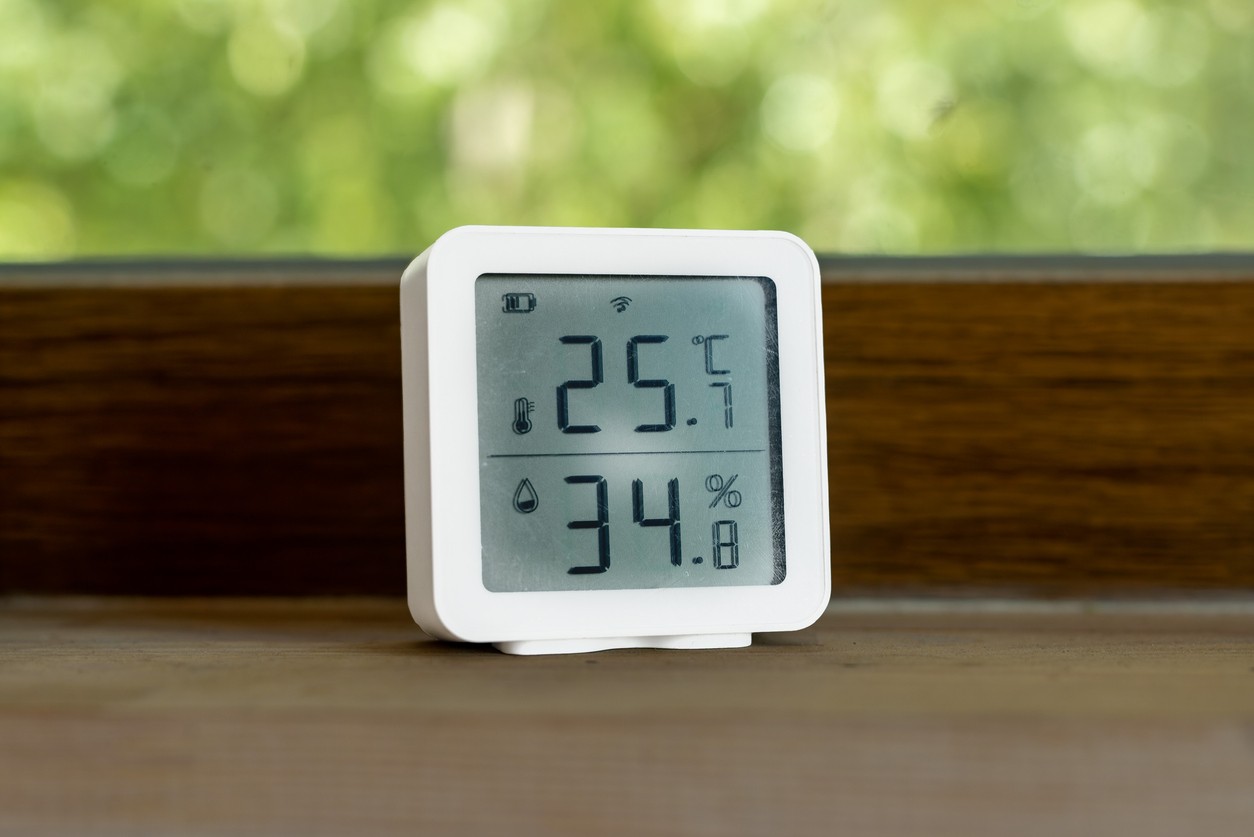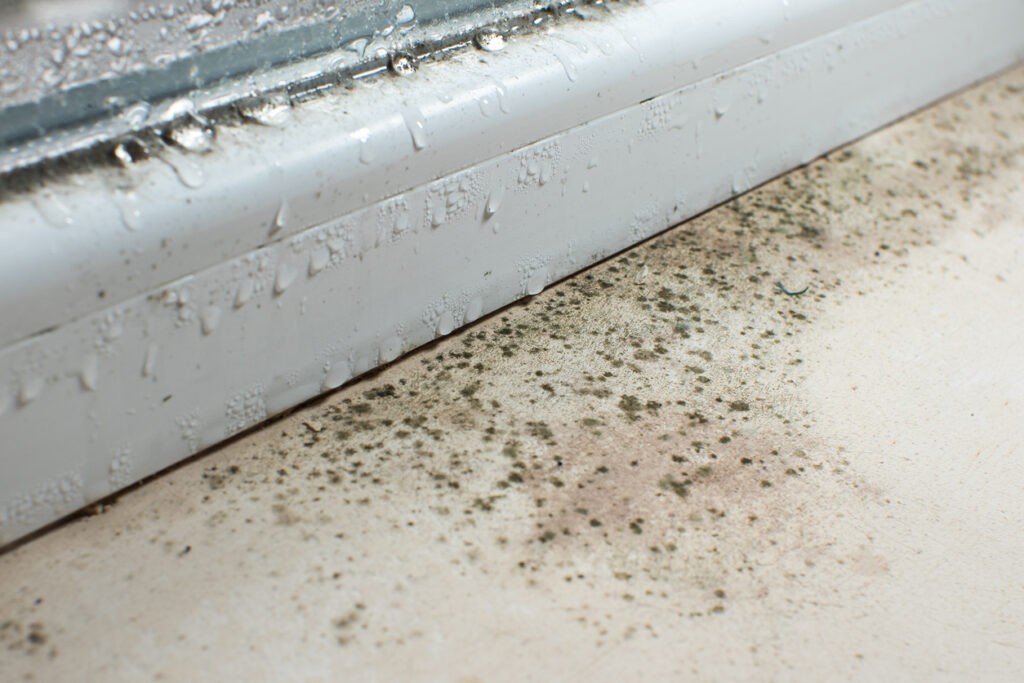High humidity is a common concern, but what exactly is it? At WHAT.EDU.VN, we break down the science and provide practical solutions for managing humidity in your home. Discover how to maintain optimal indoor air quality and prevent moisture-related issues. Find out how humidity affects your health, home, and comfort levels, and how to combat mold growth, condensation, and related problems.
1. Defining High Humidity: What Does It Mean?
High humidity refers to a condition where the air contains a significant amount of water vapor. Relative humidity, often expressed as a percentage, measures the amount of moisture in the air compared to the maximum amount the air can hold at a given temperature. For example, the Environmental Protection Agency (EPA) notes that indoor humidity should ideally be between 30-50% to prevent mold and dust mite growth. High humidity typically occurs when the relative humidity exceeds 60%.
1.1. What is Relative Humidity?
Relative humidity is a key concept. It describes how much water vapor is in the air compared to the total amount the air could hold at a specific temperature. Warm air can hold more moisture than cold air, so relative humidity changes with temperature. When relative humidity is high, the air feels heavy and damp because it’s closer to its saturation point.
1.2. Common Misconceptions About Humidity
One common misconception is that humidity only matters in hot climates. While high humidity is more noticeable in warm temperatures, it can be a problem year-round, even in cooler regions. Another misconception is that you can visually assess humidity levels accurately. While visible signs like condensation indicate high humidity, a hygrometer provides a precise measurement.
2. Identifying High Humidity: What Are the Signs?
Several indicators can help you identify high humidity in your home. Recognizing these signs early can help you take proactive steps to mitigate its effects.
2.1. Visible Signs: Condensation, Mold, and Musty Odors
One of the most obvious signs of high humidity is condensation on windows, mirrors, and other surfaces. You might also notice mold growth, especially in bathrooms, kitchens, and basements. A musty or stale odor is another common indicator, signaling the presence of mold and mildew.
2.2. Physical Symptoms: Sticky Skin and Discomfort
High humidity can make you feel uncomfortable. You might experience sticky skin, excessive sweating, and difficulty cooling down. These physical symptoms are because the high moisture content in the air reduces the effectiveness of your body’s natural cooling mechanisms.
2.3. Using a Hygrometer to Measure Humidity Levels
The most accurate way to determine humidity levels is by using a hygrometer. These devices measure the relative humidity in the air. You can find affordable hygrometers at most hardware stores or online. Regularly monitoring humidity levels allows you to take timely action when they exceed the recommended range.
Image of a hygrometer displaying humidity levels.
3. What Causes High Humidity? Understanding the Sources
Several factors can contribute to high humidity in your home. Understanding these sources can help you implement targeted strategies to control moisture levels.
3.1. Indoor Activities: Cooking, Showering, and Laundry
Everyday activities like cooking, showering, and doing laundry release moisture into the air. Boiling water, running hot showers, and using a clothes dryer can significantly increase indoor humidity levels, particularly in poorly ventilated spaces.
3.2. Poor Ventilation: Trapped Moisture and Airflow
Inadequate ventilation is a major cause of high humidity. When air cannot circulate freely, moisture becomes trapped, leading to elevated humidity levels. This issue is common in tightly sealed homes with limited airflow.
3.3. External Factors: Climate, Weather, and Location
External factors like climate, weather patterns, and geographic location can also play a role. Coastal areas and regions with frequent rainfall tend to have higher ambient humidity, which can seep into homes.
4. The Effects of High Humidity: Health, Home, and Comfort
High humidity can have several negative impacts on your health, home, and overall comfort. Understanding these effects is crucial for recognizing the importance of humidity control.
4.1. Health Issues: Allergies, Asthma, and Respiratory Problems
High humidity creates an ideal environment for allergens like dust mites and mold to thrive. According to the American Academy of Allergy, Asthma & Immunology, exposure to these allergens can trigger allergic reactions, asthma symptoms, and other respiratory problems.
4.2. Property Damage: Mold Growth, Wood Rot, and Structural Issues
Excessive moisture can lead to mold growth, wood rot, and structural damage to your home. Mold can grow on walls, ceilings, and other surfaces, while wood rot can weaken wooden structures. Over time, this can compromise the integrity of your home and require costly repairs.
4.3. Discomfort: Sticky Skin, Difficulty Cooling, and General Unease
High humidity can make you feel generally uncomfortable. The air feels heavy and damp, making it difficult for your body to cool down effectively. This can lead to sticky skin, excessive sweating, and a sense of unease, affecting your overall quality of life.
5. How to Reduce High Humidity: Practical Solutions
Fortunately, several practical solutions can help you reduce high humidity in your home. These strategies range from simple lifestyle adjustments to installing specialized equipment.
5.1. Improve Ventilation: Open Windows and Use Fans
Improving ventilation is a simple and effective way to reduce humidity. Open windows to allow fresh air to circulate, and use fans to promote airflow, especially in areas prone to moisture buildup like bathrooms and kitchens.
5.2. Use Dehumidifiers: Remove Excess Moisture
Dehumidifiers are devices that remove moisture from the air, helping to lower humidity levels. When purchasing a dehumidifier, consider the size of the room and choose a unit with an appropriate capacity. Regularly empty the water collection tank and clean the dehumidifier to maintain its efficiency.
5.3. Control Indoor Activities: Ventilation During Cooking and Showering
Be mindful of activities that generate moisture. Use exhaust fans while cooking and showering to vent steam outside. Consider taking shorter, cooler showers to reduce the amount of moisture released into the air.
5.4. Address Leaks and Water Intrusion: Fix Plumbing and Seal Cracks
Address any leaks or sources of water intrusion promptly. Repair leaky plumbing, seal cracks in walls and foundations, and ensure proper drainage around your home to prevent moisture from seeping in.
Dust mites in soft furnishings thrive in high humidity.
6. The Role of Air Conditioning: Temperature and Humidity Control
Air conditioning not only cools the air but also helps to reduce humidity. Understanding how air conditioning works in relation to humidity can help you optimize its use for better indoor air quality.
6.1. How Air Conditioners Reduce Humidity
Air conditioners cool the air by passing it over cold coils. As the air cools, moisture condenses on the coils and is drained away. This process effectively removes moisture from the air, lowering humidity levels.
6.2. Setting the Right Temperature: Balance Comfort and Humidity
Setting the right temperature on your air conditioner is important for both comfort and humidity control. Lower temperatures can reduce humidity more effectively, but it’s essential to balance this with your comfort preferences and energy consumption.
6.3. Regular Maintenance: Ensuring Optimal Performance
Regular maintenance is crucial for ensuring that your air conditioner operates efficiently. Clean or replace air filters regularly, and schedule professional servicing to check for leaks and other issues that could compromise its performance.
7. Natural Methods to Reduce Humidity: Absorbents and Plants
In addition to mechanical solutions, several natural methods can help you reduce humidity in your home. These approaches are often cost-effective and environmentally friendly.
7.1. Using Moisture Absorbents: Silica Gel and Calcium Chloride
Moisture absorbents like silica gel and calcium chloride can help to draw moisture from the air. Place these absorbents in areas with high humidity, such as closets and basements, to help keep them dry.
7.2. Houseplants That Absorb Humidity: Boston Ferns and Peace Lilies
Certain houseplants can help to absorb humidity from the air. Boston ferns, peace lilies, and spider plants are known for their ability to absorb moisture, contributing to a drier indoor environment.
7.3. Proper Placement: Maximizing the Effects
Proper placement is essential for maximizing the effects of natural humidity reduction methods. Place moisture absorbents and humidity-absorbing plants in areas where humidity is highest to achieve the best results.
8. Humidity and Your Health: Understanding the Connection
Maintaining optimal humidity levels is not just about comfort; it’s also about protecting your health. Understanding the connection between humidity and your well-being can motivate you to take proactive steps to control moisture levels.
8.1. Respiratory Health: Preventing Irritation and Infections
High humidity can exacerbate respiratory problems, leading to irritation and infections. Mold and dust mites, which thrive in humid environments, can trigger allergic reactions and asthma symptoms. Maintaining optimal humidity levels can help to reduce these risks.
8.2. Skin Health: Preventing Dryness and Irritation
While high humidity can cause discomfort, very low humidity can also be detrimental to skin health. Dry air can lead to dry, itchy skin and exacerbate conditions like eczema. Maintaining a balanced humidity level is essential for healthy skin.
8.3. Overall Well-being: Improved Sleep and Comfort
Optimal humidity levels can contribute to improved sleep and overall comfort. When the air is neither too humid nor too dry, you’re more likely to feel comfortable and relaxed, leading to better sleep and a higher quality of life.
9. Controlling Humidity in Specific Areas: Bathrooms, Kitchens, and Basements
Certain areas of your home are more prone to high humidity than others. Implementing targeted strategies for these specific areas can help you maintain consistent humidity levels throughout your home.
9.1. Bathrooms: Exhaust Fans and Proper Ventilation
Bathrooms are often the most humid areas in the home due to showering and bathing. Use exhaust fans during and after showers to vent steam outside. Ensure proper ventilation by opening windows when possible.
9.2. Kitchens: Range Hoods and Limiting Moisture
Kitchens also generate a lot of moisture through cooking. Use a range hood while cooking to vent steam and odors outside. Limit moisture production by covering pots while boiling water and avoiding leaving standing water in the sink.
9.3. Basements: Dehumidifiers and Waterproofing
Basements are prone to high humidity due to their location below ground level. Use a dehumidifier to remove excess moisture and consider waterproofing to prevent water intrusion. Ensure proper drainage around the foundation of your home.
10. Preventing Mold Growth: A Key Benefit of Humidity Control
Preventing mold growth is one of the most significant benefits of controlling humidity. Mold can cause a range of health problems and damage your home, so taking proactive steps to prevent its growth is essential.
10.1. Understanding Mold: Causes and Health Risks
Mold is a type of fungus that thrives in moist environments. It can grow on various surfaces, including walls, ceilings, and furniture. Exposure to mold can cause allergic reactions, respiratory problems, and other health issues.
10.2. Preventing Mold: Keeping Humidity Levels Low
The best way to prevent mold growth is by keeping humidity levels low. Aim to maintain indoor humidity between 30-50%. Address any sources of moisture promptly and ensure proper ventilation.
10.3. Remediation: Addressing Existing Mold Problems
If you already have mold in your home, it’s essential to address the problem promptly. Small areas of mold can often be cleaned with a mixture of bleach and water. Larger areas of mold may require professional remediation services.
Mold thrives in environments with high humidity.
11. Seasonal Humidity: Adjusting Strategies Throughout the Year
Humidity levels can vary significantly throughout the year, so it’s important to adjust your strategies accordingly. Understanding seasonal humidity patterns can help you maintain consistent humidity levels year-round.
11.1. Summer Humidity: Focus on Cooling and Dehumidification
During the summer, humidity levels tend to be higher due to warmer temperatures and increased rainfall. Focus on cooling and dehumidification to maintain comfort and prevent mold growth. Use air conditioning and dehumidifiers as needed.
11.2. Winter Humidity: Balancing Humidity to Prevent Dryness
In the winter, humidity levels can drop due to cold temperatures and heating systems. While it’s important to prevent high humidity, it’s also essential to avoid excessive dryness. Use humidifiers to add moisture to the air if needed.
11.3. Spring and Fall: Transition Strategies for Moderate Humidity
Spring and fall typically have moderate humidity levels, so you may need to adjust your strategies accordingly. Monitor humidity levels regularly and make adjustments as needed to maintain a comfortable and healthy indoor environment.
12. High Humidity and Your Home’s Structure: Protecting Your Investment
High humidity can have a significant impact on your home’s structure, leading to costly repairs and reduced property value. Protecting your investment by controlling humidity is essential for long-term homeownership.
12.1. Wood Damage: Rotting and Warping
Excessive moisture can cause wood to rot and warp, compromising the structural integrity of your home. This is particularly common in areas like basements, crawl spaces, and attics.
12.2. Paint and Wallpaper: Peeling and Bubbling
High humidity can cause paint and wallpaper to peel and bubble, detracting from the appearance of your home. Moisture can seep behind these surfaces, causing them to lose adhesion and eventually fail.
12.3. Structural Integrity: Preventing Long-Term Damage
By controlling humidity levels, you can prevent long-term damage to your home’s structure. Addressing moisture issues promptly can help you avoid costly repairs and maintain the value of your property.
13. When to Call a Professional: Identifying Serious Humidity Problems
While many humidity problems can be addressed with DIY solutions, some situations require professional help. Knowing when to call a professional can help you avoid serious health and property damage.
13.1. Persistent Mold Growth: Professional Remediation
If you have persistent mold growth despite your best efforts to control humidity, it’s time to call a professional. Mold remediation experts have the tools and expertise to safely and effectively remove mold from your home.
13.2. Structural Damage: Expert Assessment and Repair
If you notice signs of structural damage, such as wood rot or foundation cracks, it’s important to seek expert assessment and repair. Structural engineers and contractors can evaluate the damage and recommend appropriate solutions.
13.3. Unexplained High Humidity: Identifying Hidden Sources
If you’re experiencing unexplained high humidity, there may be hidden sources of moisture that you’re not aware of. Professional home inspectors can identify these sources and recommend solutions to address them.
14. The Cost of High Humidity: Financial Implications and Prevention
High humidity can have significant financial implications, from increased energy bills to costly repairs. Understanding the costs associated with high humidity can help you appreciate the value of prevention.
14.1. Increased Energy Bills: Air Conditioning and Dehumidification
Running air conditioning and dehumidifiers to control humidity can increase your energy bills. However, the cost of these measures is often less than the cost of repairing damage caused by high humidity.
14.2. Repair Costs: Mold Remediation and Structural Repairs
Mold remediation and structural repairs can be expensive. Addressing moisture issues promptly can help you avoid these costs and protect your investment in your home.
14.3. Long-Term Savings: Preventing Damage and Health Issues
In the long term, controlling humidity can save you money by preventing damage to your home and reducing the risk of health issues. Investing in humidity control measures is a wise investment in your health and property.
15. Common Myths About Humidity: Debunking Misconceptions
Several myths and misconceptions surround humidity. Debunking these myths can help you make informed decisions about humidity control.
15.1. Myth: Humidity Only Matters in Hot Climates
One common myth is that humidity only matters in hot climates. While high humidity is more noticeable in warm temperatures, it can be a problem year-round, even in cooler regions.
15.2. Myth: You Can Visually Assess Humidity Levels Accurately
Another myth is that you can visually assess humidity levels accurately. While visible signs like condensation indicate high humidity, a hygrometer provides a precise measurement.
15.3. Myth: Opening Windows Always Reduces Humidity
Opening windows can reduce humidity, but it’s not always the case. If the humidity is higher outside than inside, opening windows can actually increase indoor humidity.
16. Innovations in Humidity Control: New Technologies and Solutions
The field of humidity control is constantly evolving, with new technologies and solutions emerging regularly. Staying informed about these innovations can help you find the most effective strategies for your home.
16.1. Smart Dehumidifiers: Automated Humidity Control
Smart dehumidifiers offer automated humidity control, allowing you to set desired humidity levels and monitor performance remotely. These devices can adjust their operation based on real-time conditions, providing optimal humidity control.
16.2. Whole-House Ventilation Systems: Improved Air Quality
Whole-house ventilation systems provide continuous airflow, helping to reduce humidity and improve indoor air quality. These systems can be integrated with your HVAC system for efficient and effective ventilation.
16.3. Moisture-Resistant Building Materials: Preventing Damage
Moisture-resistant building materials can help to prevent damage caused by high humidity. These materials are designed to resist moisture absorption, reducing the risk of mold growth and structural damage.
17. Maintaining a Healthy Home: Humidity as Part of a Holistic Approach
Controlling humidity is just one aspect of maintaining a healthy home. A holistic approach considers all factors that contribute to indoor air quality and overall well-being.
17.1. Air Quality: Ventilation and Filtration
In addition to controlling humidity, it’s important to focus on air quality by ensuring proper ventilation and filtration. Use air purifiers to remove pollutants and allergens from the air.
17.2. Temperature Control: Comfort and Energy Efficiency
Maintaining comfortable temperatures is essential for both comfort and energy efficiency. Use a programmable thermostat to adjust temperatures based on your schedule.
17.3. Regular Cleaning: Preventing Dust and Allergens
Regular cleaning can help to prevent dust and allergens from accumulating in your home. Vacuum regularly, dust surfaces, and wash bedding frequently to maintain a clean and healthy indoor environment.
18. Case Studies: Real-World Examples of Humidity Control
Examining real-world case studies can provide valuable insights into the effectiveness of different humidity control strategies. These examples can help you understand how to address specific humidity problems in your own home.
18.1. Preventing Mold in a Humid Climate
A homeowner in a humid climate installed a whole-house dehumidifier to maintain consistent humidity levels. This prevented mold growth and improved indoor air quality, resulting in a healthier and more comfortable home.
18.2. Addressing Basement Moisture Issues
A homeowner addressed basement moisture issues by installing a dehumidifier and sealing cracks in the foundation. This reduced humidity levels and prevented water intrusion, protecting the home’s structural integrity.
18.3. Improving Respiratory Health with Humidity Control
A family with asthma improved their respiratory health by controlling humidity levels in their home. They used air conditioning and dehumidifiers to maintain optimal humidity, reducing exposure to allergens and irritants.
19. Resources for Further Learning: Where to Find More Information
Numerous resources are available for further learning about humidity control. These resources can provide more in-depth information and guidance on addressing specific humidity problems.
19.1. Government Agencies: EPA and CDC
Government agencies like the EPA and CDC offer valuable information on indoor air quality and humidity control. Their websites provide guidance on maintaining a healthy home environment.
19.2. Professional Organizations: ASHRAE and ACCA
Professional organizations like ASHRAE and ACCA offer technical resources and training for HVAC professionals. Their websites provide information on best practices for humidity control.
19.3. Educational Websites: WHAT.EDU.VN and Others
Educational websites like WHAT.EDU.VN provide accessible information on a wide range of topics related to home maintenance and health, including humidity control.
20. Frequently Asked Questions (FAQs) About High Humidity
Addressing frequently asked questions can help to clarify common concerns and provide practical guidance on humidity control.
| Question | Answer |
|---|---|
| What is the ideal humidity level? | The ideal indoor relative humidity is between 30% and 50%. |
| How do I measure humidity? | Use a hygrometer to measure the relative humidity in your home. |
| What are the signs of high humidity? | Signs include condensation, mold growth, musty odors, and sticky skin. |
| How can I reduce humidity in my bathroom? | Use exhaust fans during and after showers, and ensure proper ventilation. |
| What are the health risks of high humidity? | High humidity can exacerbate respiratory problems, trigger allergies, and promote mold growth. |
| Can houseplants help reduce humidity? | Yes, certain houseplants like Boston ferns and peace lilies can help absorb moisture from the air. |
| How does air conditioning reduce humidity? | Air conditioners cool the air, causing moisture to condense on the coils and drain away. |
| When should I call a professional about humidity? | Call a professional if you have persistent mold growth, structural damage, or unexplained high humidity. |
| What are the costs associated with high humidity? | Costs include increased energy bills, repair costs for mold remediation and structural repairs, and potential health issues. |
| How can I prevent mold growth? | Keep humidity levels low, address sources of moisture promptly, and ensure proper ventilation. |



High humidity can significantly affect your health, home, and comfort. By understanding the causes, effects, and solutions, you can take proactive steps to control humidity levels and maintain a healthy and comfortable indoor environment.
Do you have more questions about managing humidity or any other home-related topics? Don’t hesitate to ask! At WHAT.EDU.VN, we’re here to provide you with fast, free answers to all your questions. Visit our website at what.edu.vn, or contact us at 888 Question City Plaza, Seattle, WA 98101, United States, or via WhatsApp at +1 (206) 555-7890. We’re ready to help you find the information you need.
